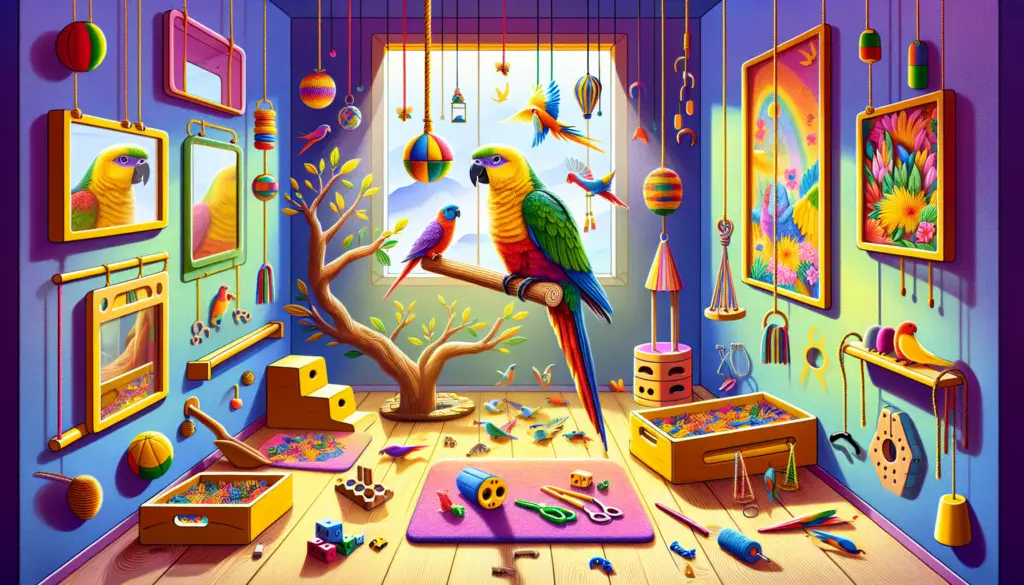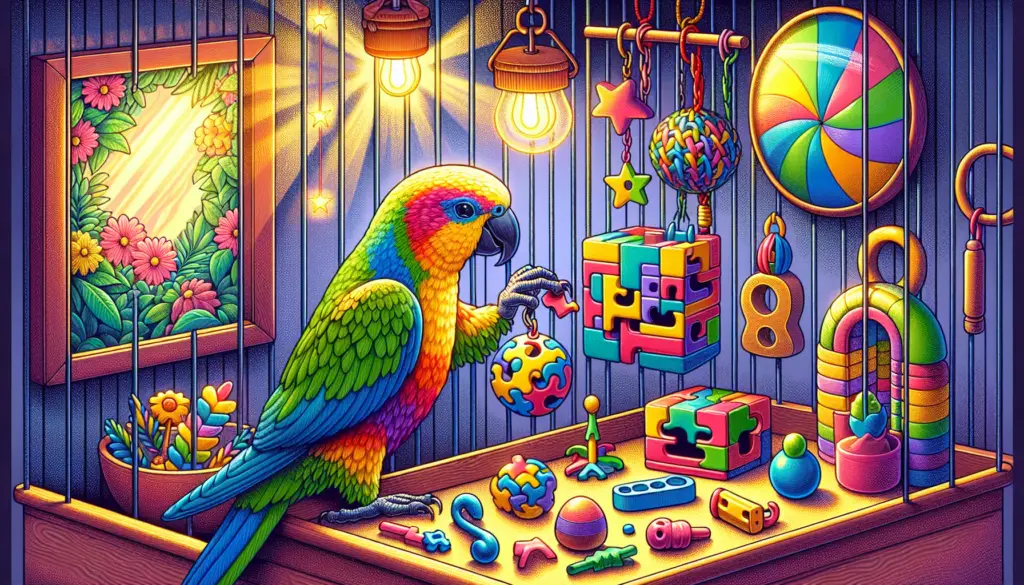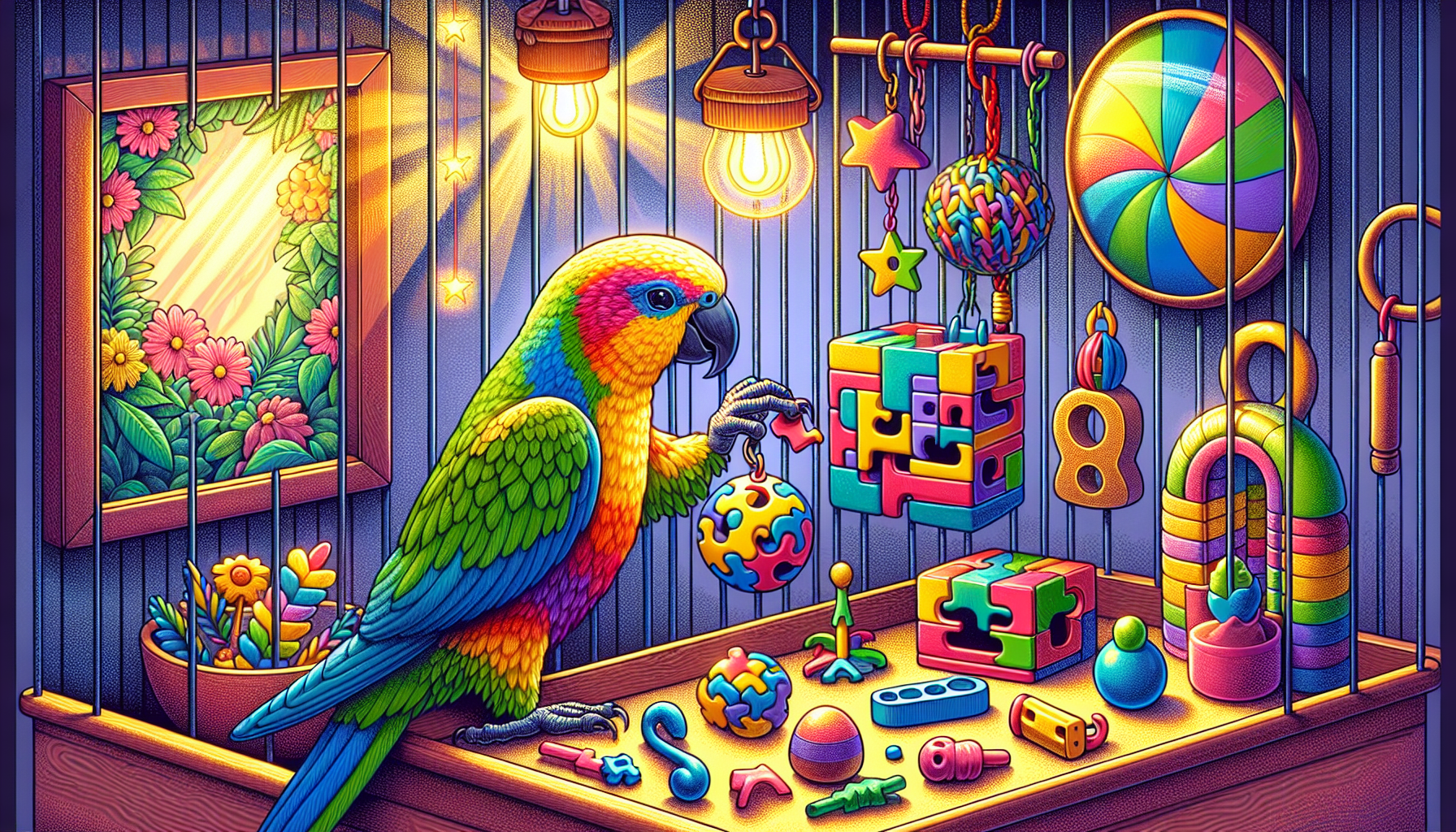If you’ve recently brought home a new feathered friend or have noticed your parrot displaying signs of loneliness, you might be wondering how to keep them happy and engaged. Parrots are highly social creatures and need plenty of mental stimulation and interaction to thrive. Fortunately, there are several simple and effective ways to ensure that your parrot feels loved, connected, and never alone. From providing companionship through playtime to creating an enriching environment, we’ll guide you on how to keep your parrot from getting lonely, enhancing their overall well-being and happiness.

Environment
Provide a spacious cage
One of the first steps in keeping your parrot from getting lonely is to provide them with a spacious cage. A small cage can make your parrot feel confined and unhappy. It’s important to choose a cage that is large enough for your parrot to move around comfortably and stretch their wings. Make sure the cage has horizontal bars for climbing and enough space for toys and perches.
Include perches and toys
To create a stimulating environment for your parrot, include perches and toys in their cage. Perches allow your parrot to exercise their feet and provide different levels for them to explore. Additionally, toys are essential for mental stimulation and entertainment. Choose a variety of toys that cater to different senses, such as chewable toys, puzzle toys, and bells. Rotate the toys regularly to keep your parrot engaged and prevent boredom.
Arrange cage near family activities
Parrots are social creatures and thrive on human interaction. To prevent your parrot from feeling lonely, it’s beneficial to arrange their cage near family activities. This allows your parrot to observe and be a part of daily household routines. They will feel more connected to you and your family, reducing feelings of isolation. Place the cage in a common area, such as the living room, where your parrot can interact with you and enjoy the company.
Social Interaction
Spend quality time with your parrot
One of the most crucial factors in preventing loneliness for your parrot is spending quality time with them. Parrots need social interaction and companionship with their owners. Set aside dedicated time each day to interact and bond with your parrot. This can include talking to them, teaching them tricks, or simply being present in the same room. Your parrot will appreciate the attention and love, and it will help to alleviate any feelings of loneliness.
Engage in interactive play
Interactive play is an excellent way to keep your parrot mentally and physically stimulated while also strengthening your bond. Play games with your parrot, such as tossing toys for them to catch or teaching them how to play with puzzle toys. You can also engage in activities like hide-and-seek or teaching them to retrieve objects. By engaging in interactive play, you provide your parrot with both entertainment and social interaction.
Teach and train your parrot
Training your parrot not only helps them learn new skills and behaviors but also fosters a strong bond between you. Spend time teaching your parrot simple commands or tricks using positive reinforcement techniques. Use treats as rewards and praise them for their accomplishments. Training sessions provide mental stimulation and social interaction, preventing your parrot from feeling lonely. It also helps to establish trust and mutual understanding between you and your feathered friend.
Introduce a Companion
Consider getting another parrot
If you have the means and time to care for multiple parrots, consider getting another parrot as a companion for your lonely parrot. Parrots are highly social animals and usually enjoy the company of their own species. However, it’s important to note that not all parrots will get along with each other. Research different parrot species to find one that is compatible with your existing parrot’s temperament and preferences. If possible, let your parrot meet the potential companion before making a decision.
Ensure compatibility before introducing
Before introducing a new parrot to your home, it’s essential to ensure compatibility between the two birds. Each parrot has its own personality and preferences, and not all parrots will get along. Consult with an avian veterinarian or a parrot behaviorist to assess the compatibility between your current parrot and the potential companion. This will help prevent any aggressive or territorial behavior and ensure a harmonious living environment for both birds.
Gradually introduce the new parrot
Once you have chosen a suitable companion for your parrot, it’s crucial to introduce them gradually to minimize stress and potential conflicts. Start by placing their cages near each other, allowing them to observe and become familiar with each other’s presence. As they become more comfortable, you can proceed to supervised face-to-face interactions, ensuring both birds are safe and showing positive behaviors. Be patient during the introduction process, as it may take time for the birds to establish a bond.

Mimic Natural Environment
Create a stimulating environment
Parrots thrive in environments that mimic their natural habitat. To prevent loneliness and stimulate your parrot mentally, create an environment that closely resembles their wild counterparts. Provide various perches at different heights and textures, allowing your parrot to simulate natural movement and exercise. Incorporate different textures, such as wooden branches or ropes, to enhance their climbing experience. Additionally, offer a variety of interactive toys and activities to keep them engaged.
Provide a variety of natural sounds
In the wild, parrots are surrounded by a symphony of natural sounds. To mimic their natural environment and prevent loneliness, provide your parrot with a variety of natural sounds. This can include playing recordings of bird songs, rainforest sounds, or other environmental noises. However, make sure the volume is not too loud to avoid overwhelming your parrot. The combination of these sounds will provide auditory enrichment and make your parrot feel more connected to nature.
Add plants and natural materials to the cage
Introducing plants and natural materials to your parrot’s cage can simulate a more natural environment and prevent feelings of loneliness. Choose safe, non-toxic plants that can withstand the parrot’s presence. These plants not only provide visual stimulation but also contribute to their overall well-being by improving air quality. Additionally, consider adding natural materials like untreated wood, branches, or digging boxes for your parrot to explore and interact with.
Background Noise
Keep the TV or radio on
Parrots are intelligent and social animals that enjoy the presence of background noise. Keeping the TV or radio on when you’re not at home can provide comfort and prevent feelings of isolation for your parrot. Choose channels or stations that broadcast nature shows, talk shows, or music that your parrot seems to respond positively to. The sound of human voices and familiar melodies can create a sense of companionship and make your parrot feel less alone.
Play soothing music or nature sounds
In addition to background noise, playing soothing music or nature sounds during the day can help keep your parrot calm and prevent loneliness. Parrots have been shown to have preferences for certain types of music, so experiment with different genres to see what your parrot enjoys. Additionally, nature sounds like flowing water or rainforest ambiance can create a serene atmosphere for your parrot, providing a sense of relaxation and tranquility.
Use white noise machines if necessary
If your parrot seems to be particularly sensitive to external noises or the environment is exceptionally quiet, consider using a white noise machine. White noise machines emit a steady stream of soothing background noise, similar to the sound of a fan or flowing water. This constant sound can help mask unsettling noises and create a continuous background noise that can be comforting for your parrot.
Positive Reinforcement
Use treats and rewards
Positive reinforcement is a crucial aspect of parrot training and can also help prevent loneliness. Use treats as rewards when your parrot exhibits desired behaviors or successfully learns a new trick. This reinforces positive associations and encourages your parrot to engage in social interaction and training sessions. However, it’s important to provide treats in moderation and ensure they are healthy and suitable for your parrot’s diet.
Praise and pet your parrot
In addition to treats, praise and physical affection are essential forms of positive reinforcement for your parrot. Parrots are sensitive to human emotions and respond positively to vocal affirmations and gentle petting. When your parrot behaves well or follows commands, make sure to use a positive and soothing tone of voice to acknowledge their good behavior. Regular physical contact, such as head scratches or gentle wing strokes, can also foster a sense of security and comfort.
Utilize clicker training
Clicker training is a highly effective method of positive reinforcement for parrots. It involves using a small handheld device called a clicker to make a distinct clicking sound each time your parrot performs the desired behavior. By associating the sound of the clicker with a positive reward, such as a treat, your parrot will learn to repeat the behavior for future rewards. Clicker training enhances mental stimulation, strengthens the bond between you and your parrot, and keeps them engaged and motivated.
Avoiding Punishment
Do not yell or scream at your parrot
When trying to prevent loneliness in your parrot, it’s crucial to avoid any form of punishment, especially yelling or screaming. Parrots are sensitive creatures and can easily become stressed or anxious in response to loud noises or aggression. Yelling or screaming can be interpreted as a threat, causing your parrot to feel fear and isolation. Instead, maintain a calm and patient approach when interacting with your parrot, using positive reinforcement to encourage desired behaviors.
Avoid physical punishment
Physical punishment should never be used as a means to discipline your parrot. Hitting, smacking, or any form of physical harm can cause severe emotional and physical distress to your parrot. Not only does it create a negative and fearful environment, but it also damages the trust and bond between you and your parrot. Focus on positive reinforcement techniques and redirection rather than punitive measures.
Use positive reinforcement for desired behaviors
Positive reinforcement is the key to shaping your parrot’s behavior and preventing loneliness. Instead of punishing unwanted behaviors, redirect your parrot’s attention to more positive activities. For example, if your parrot is exhibiting excessive screaming, offer them an engaging toy or initiate interactive play to divert their focus. By rewarding desired behaviors and providing alternatives to unwanted behaviors, you can create a positive learning environment for your parrot.
Routine and Predictability
Establish a consistent daily routine
Parrots thrive on routine and predictability. Establishing a consistent daily routine can help alleviate feelings of loneliness and provide your parrot with a sense of security and stability. Set specific times for feeding, playtime, training sessions, and social interaction. Consistency in routine creates a sense of familiarity and reduces anxiety for your parrot. Stick to the established routine as closely as possible, and your parrot will appreciate the predictability in their daily life.
Keep feeding and playtimes regular
Feeding and playtimes are fundamental aspects of your parrot’s daily routine. Regularly scheduled mealtimes ensure that your parrot receives consistent nourishment and helps maintain their overall health. Additionally, regular playtimes provide mental stimulation and social interaction. Engage in interactive play with your parrot at the same time each day, incorporating toys and training sessions. Consistency in these activities helps your parrot anticipate and look forward to these essential interactions.
Provide a stable and secure environment
Creating a stable and secure environment is crucial for preventing loneliness in your parrot. Ensure that their cage is in a secure location, away from potential hazards or stressful environments. Avoid relocating the cage frequently, as this can cause distress and anxiety for your parrot. Additionally, maintain a consistent temperature and lighting condition in their living space. A stable environment provides a sense of safety and comfort, minimizing feelings of loneliness.
Environmental Enrichment
Rotate toys and introduce new ones
To prevent boredom and loneliness, it’s essential to provide environmental enrichment for your parrot. One way to achieve this is by rotating their toys regularly. Remove a few toys from the cage and introduce new ones to keep your parrot engaged and curious. Consider a variety of toys that cater to different senses, such as puzzle toys, bells, or toys that require foraging. By offering new and stimulating toys, you provide mental and physical stimulation for your parrot.
Offer foraging opportunities
In the wild, parrots spend a significant amount of time foraging for food. Recreate this natural behavior in your parrot’s daily routine by offering foraging opportunities. Hide treats or pellets within toys or wrap them in paper for your parrot to discover. This encourages natural foraging behaviors and provides a stimulating and rewarding activity. Foraging not only prevents loneliness but also enhances problem-solving skills and mental enrichment.
Provide mental stimulation activities
Mental stimulation is crucial for preventing loneliness and boredom in parrots. Provide your parrot with a variety of mental stimulation activities, such as puzzle toys or teaching them to mimic certain actions. Engage them in problem-solving games or train them to identify colors or shapes. These activities not only prevent loneliness but also enhance your parrot’s cognitive abilities and strengthen their bond with you.
Professional Assistance
Consult with an avian veterinarian
If you’re struggling to keep your parrot from getting lonely or are concerned about their well-being, it’s always a good idea to consult with an avian veterinarian. They can assess your parrot’s overall health, behavior, and provide valuable guidance on preventing loneliness. They can also offer advice specific to your parrot’s breed or individual needs. Regular check-ups ensure that any underlying health issues are addressed promptly and contribute to your parrot’s overall happiness.
Join parrot support groups
Joining parrot support groups or online forums can provide valuable insights and support from fellow parrot owners. These communities often share experiences, tips, and advice on keeping parrots happy and fulfilled. Engaging with like-minded individuals who understand the unique challenges of parrot ownership can be both informative and comforting. Through these support groups, you can learn from others’ experiences and foster a sense of community for you and your parrot.
Consider hiring a parrot behaviorist or trainer
If you’re facing significant challenges in preventing loneliness or addressing behavioral issues in your parrot, it may be beneficial to hire a professional parrot behaviorist or trainer. These specialists have expertise in understanding parrot behavior and can provide personalized guidance and training techniques. They can tailor a plan to meet the specific needs and challenges of your parrot, ensuring a happier and more socially fulfilled life for your feathered friend.
In conclusion, preventing loneliness in your parrot requires a holistic approach that incorporates elements such as providing a spacious cage, spending quality time with them, mimicking their natural environment, and implementing positive reinforcement techniques. By following these guidelines, you can create a thriving and socially enriched environment for your parrot, ensuring their overall well-being and happiness. Remember, your parrot’s mental and emotional health is just as important as their physical health, and a little effort goes a long way in keeping them from getting lonely.

My name is Shane Warren, the author behind Your Bird Buddy – your ultimate guide to the wonderful world of birds! Unleash your inner avian explorer as we delve into a vibrant library of knowledge dedicated to all things feathered. From learning about diverse bird species from across the globe to understanding their captivating habitats and behaviors, I’m here to fuel your passion for these magnificent creatures. Not only that, but I also provide valuable insights on being a responsible and informed pet bird owner. Join our vibrant community and let’s celebrate the feathered wonders of the world together – one chirp at a time. And be sure to join our Your Bird Buddy Community over on Facebook!


Comments are closed